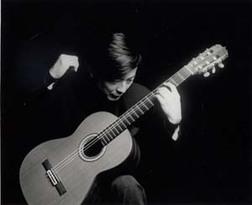
Yamashita first came to the attention of the guitar world over 20 years ago with his spectacular arrangement of Pictures at an Exhibition, by Modest Mussorgsky. A showpiece for virtuoso pianists, and familiar in various arrangements for orchestra, it did not seem to be a likely source for an arrangement for solo guitar, but Yamashita succeeded in performing the piece brilliantly and made a lasting impression, through his use of a broad color palette, an extraordinary dynamic range, and an amazing instrumental technique. The same assets were evident, and thrilled many, during Yamashita’s performances of Bach on Friday evening, yet in ways that I often found ill-suited to the music.
Each of Bach’s six cello suites takes the form of a group of Baroque dances, which the composer transforms into personal and profound spiritual statements. In these works, Bach creates the illusion of a full harmonic and contrapuntal texture by means of single melodic lines that outline or suggest an interplay of independent voices. It is a technique originally developed by lute composers and perfectly suited to the guitar, yet Yamashita’s performance was a major disappointment.
The First and Sixth Cello Suites both begin with simple, ornamented arpeggios and gradually acquire celebratory overtones. Both preludes feature a joyous exploration of resonating harmony and flower into exultant cascades. Yamashita randomly accented various notes of the opening figures and created a bewildering effect. The 16th-note passage at the end of the Sixth Suite Prelude, while technically impressive, was forced and created the impression of a mere virtuoso showpiece. The following movements each failed to convey the dance rhythm that is their essence. The Allemande and Sarabande of the Sixth Suite were given such a flexible pulse that they simply meandered. The Courante, Gavottes, and Gigue in both suites were characterized by a relentless drive and muscularity.
Bach’s Second Sonata for Solo Violin also creates the illusion of a full texture with single melodic lines, though it makes more use of chords and counterpoint than the Cello Suites. Yamashita used his control of dynamics to make clear the improvisatory melody and the guiding bass line of the opening Grave but again broke the continuity of the lines with seemingly random accentuation. The Fugue, though stunningly fast, was an unintelligible stew in which the various voices were indistinguishable. The Andante called forth some of the best playing of the evening. The repeated bass notes were well-paced and the singing melody was beautifully shaped. The final Allegro was taken at a blistering pace but many of the 32nd notes were unclear. The relentless drive left little room for nuance but delighted a portion of the audience.

